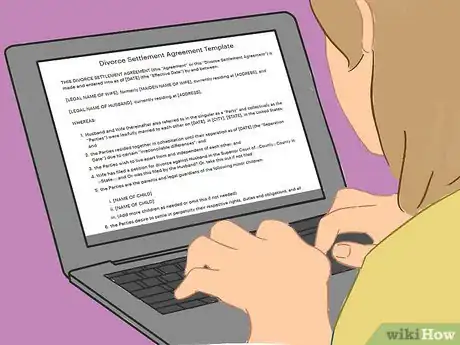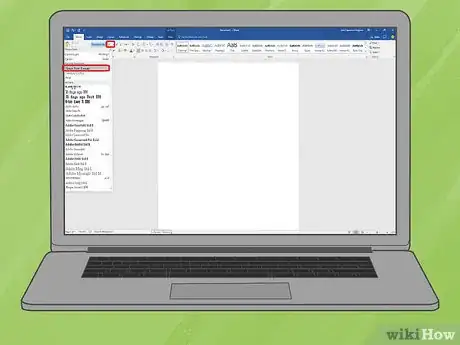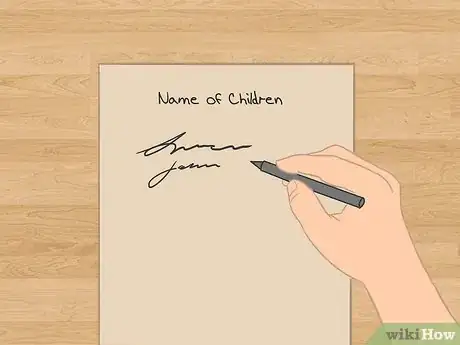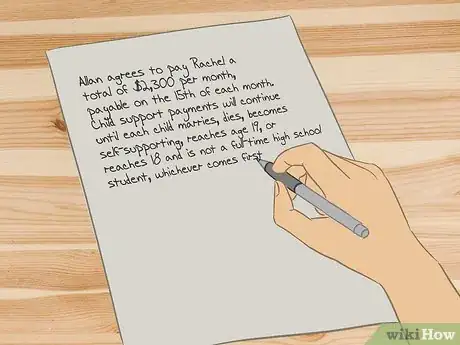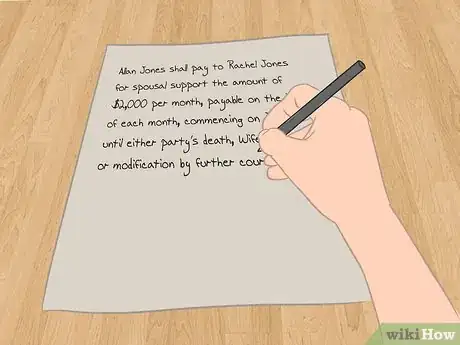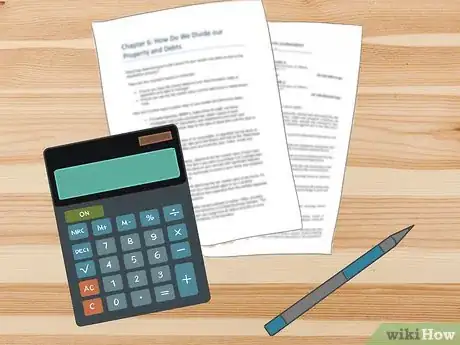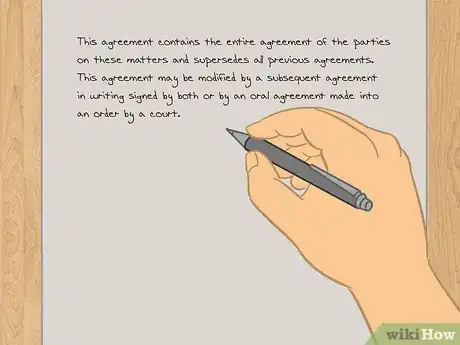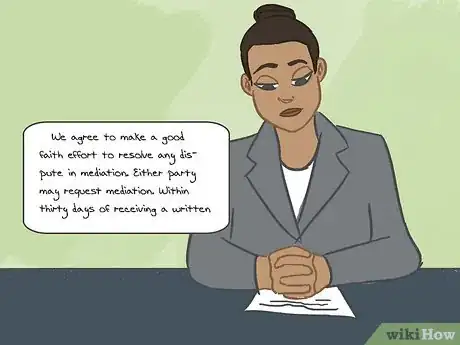This article was co-authored by Valery Cury. Valery Cury is an Immigration Attorney based in Santa Ana, California. With over seven years of experience, she specializes in affirmative cases. Valery earned her Master’s Degree from Brooklyn Law School and her Bachelor’s Degree in Law from Pontificia Universidad Catolica Madre y Maestra in the Dominican Republic. She is licensed to practice in the State of Connecticut. She’s also a member of the American Immigration Lawyers Association (AILA) and the Dominican Bar Association (DBA).
There are 12 references cited in this article, which can be found at the bottom of the page.
This article has been viewed 56,427 times.
In California, a divorce settlement agreement is called a marriage settlement agreement. In this document, you and your spouse decide how you will divide your property and child custody. You can also agree to child support payments, spousal support (alimony), and whether to sell your house. If you can’t reach an agreement with your spouse, then a judge will have to decide these issues. You can prepare by thinking about what you want and then scheduling a time to talk with your spouse. Once you have hammered out details, one of you should draft the agreement. Don’t sign until each person has met with their own lawyer to review the draft.
Steps
Talking with Your Spouse
-
1Decide what you want. You will be more effective if you decide ahead of time what you want. Do you want full custody of the children? Do you want spousal support? And if you do, how much support do you need? To answer these questions, do the following:
- Identify where you want to live. You might want to stay in your house because you have a job nearby or for another reason. If you want to move, figure out where.
- Come up with a budget. As best as you can, you should estimate your expenses and compare the amount to your expected income.
-
2Learn California’s community property rules. California is a community property state. Accordingly, most property you acquired during your marriage is community property. The same is true of any debt acquired. All earnings are community property and anything bought with those earnings is as well.[1] Generally, community property is divided equally between spouses upon divorce.
- Separate property is not community property. It can include anything you acquired before the marriage. Gifts or inheritances are separate property as well.
- Anything you acquire after separation is also separate property. For example, the money you earn after you separate from your spouse is your separate property.
- If you aren’t sure what is community or separate property, you can ask an attorney.
Advertisement -
3Meet with an attorney. Before beginning to negotiate a settlement agreement, you should meet with an attorney. Only a qualified California attorney can explain your rights to you. You don’t want to give up anything in your divorce settlement agreement that you are entitled to.
- You can get a referral to a divorce attorney by finding a certified referral service. Call toll free 866-442-2529. If you are outside the state, call 415-538-2250.[2]
- Also ask any divorced acquaintances if they would recommend their divorce lawyer.
-
4Schedule a time to talk with your spouse. Try to find a time when the children aren’t in the house and when you can focus solely on the task at hand. Realize that it might take multiple sessions to reach an agreement on all issues, so don’t plan to finish in an hour.
- Approach your spouse and say, “We really need to talk about where the children will live and child support. When are you available?”
- If possible, meet in person and not over the phone.
-
5Come up with a task list. You want your divorce settlement agreement to be comprehensive. Accordingly, you should come up with a task list or checklist that you can work through as a couple. With each person having a list, you have something to focus on. A comprehensive settlement agreement will cover the following:
- Child custody. There are two kinds of custody: legal and physical. With legal custody, you get to make decisions for the child, such as where they go to school, what medical treatment they get, etc. Physical custody means the child spends time with you.[3] One parent can have primary physical custody and the other can have visitation. Be as detailed as possible about your parenting plan.
- Child support. You can agree to a child support amount, but realize that the judge must approve the amount. A judge always decides what is in the best interests of the child, and you’ll need to research California’s guidelines on child support.
- Division of property. Sit down and come up with a list of everything you own. Each person should fill out a Schedule of Assets and Debts, which you’ll have to file with your divorce petition.[4] You can get the form from your court clerk or download it from online.
- Division of debt. Decide who will handle the debt and whether you will transfer it into one person’s name. For example, a joint credit card debt could be transferred to a credit card in the name of only one person.
- Spousal support. You might want to seek alimony, called spousal support. In California, you probably won’t get support for more than half of the years you were married if married for less than ten. However, if you were married for more than 10, then the court won’t set a definite termination date.[5]
-
6Listen carefully. Emotions might be running high when you sit down to hammer out your divorce settlement agreement. For this reason, active listening is critical. Try to remember the following tips, which can make the conversation go more smoothly:
- Sit with an open body style. Don’t cross your arms and legs or angle your body away from your spouse.[6] Face him or her and sit naturally.
- Make eye contact. You want to show your spouse that you are listening and take what they say seriously.
- Avoid talking over each other.
- Mirror what your spouse is saying. If your spouse says she needs full-time custody, say, “I definitely hear you want John and Mary to live with you. But since I’m not moving far away, I think we should consider splitting physical custody.”
-
7Take detailed notes. Both spouses should take notes. If only one does, then the other might claim the notes are inaccurate. At the end of your negotiations, you should compare notes and resolve any disagreements.
- Assign one person to draft the divorce settlement agreement based on the notes.
- Don’t take too long drafting an agreement. The longer you wait, the more of a chance your spouse has to change their mind.
-
8Attend mediation if necessary. If you can’t reach agreement, then consider mediation. In mediation, a neutral third party will listen to the dispute and get you talking to each other. Mediators typically charge $50-200 an hour. You can split the cost with your spouse.[7]
- Find mediators in your phone book or on the Internet. Alternately, you could contact your local bar association or stop into court and ask if they have a roster of mediators.[8]
Beginning to Draft the Agreement
-
1Format your document. You want your divorce settlement agreement to be readable, so set up a blank word processing document using a font size and style you find comfortable. Times New Roman 12 point font works for many people.
- The California Courts has a model marital settlement agreement you can use. You can download the document here: http://www.courts.ca.gov/partners/documents/marital_settlement_agreement.pdf. Use this as a model for your own agreement.
-
2Identify key facts of the marriage. Open the divorce settlement agreement with basic information about who you are. Include details about your marriage, such as the following:
- Names of the spouses. You can write, “I, Allan Jones, Husband, and I, Rachel Jones, Wife, agree as follows….”
- Dates of marriage and separation. Write something like, “We were married on the 3rd day of May, 2001, and separated on the 15th day of January, 2016.”
- Why you are divorcing. Include a line or two about why the marriage is ending. Generally, most people divorce for “irreconcilable differences,” which is a catch-all. Also mention the marriage has “irretrievably broken down.”[9]
-
3Name your children. Include their ages and date of birth. If you had no children, then you can include a provision stating, “There are no children from the marriage.”[10]
Explaining Custody and Child Support
-
1Assign physical and legal custody. Generally, you will have either joint custody, joint legal custody with primary physical custody, or sole custody with visitation. You should explain which one you have chosen.
- For example, you could write: “Allan and Rachel shall jointly share physical and legal custody of the minor children. Our relationship will be guided by the following terms and conditions….” Then insert the information from your parenting plan.[11]
- If you drafted a visitation schedule, then you can attach it to your settlement agreement. Direct the reader to the attachment. For example, you could write, “Allan Jones shall have visitation with the minor children as follows: See Attachment ‘A,’ consisting of 10 pages, incorporated herein by reference.” This is probably the easiest and cleanest way to refer to the visitation schedule.
-
2Confirm a child support order. There might already be a child support order in place. You have the option of confirming it and incorporating it into your divorce settlement agreement. If so, include a provision to that effect.
- Sample language could read, “A child support order was filed on January 22, 2016 in the parties’ dissolution case. This child support, in its entirety, shall remain in effect and is hereby incorporated by reference into this agreement.”[12]
-
3Defer child support instead. You might sign the divorce settlement agreement before a court has decided child support. In that situation, you can simply defer the issue. State the hearing date (if you know it).
- If a child support hearing hasn’t even been scheduled, then you can reserve the issue of child support. The California marital settlement agreement has sample language you can use.
-
4State your child support. If you’ve come to an agreement, then you should state how much will be paid in child support and who will pay it. Include the date it will be paid and when child support will end.
- For example, you could write, “Allan agrees to pay Rachel a total of $2,300 per month, payable on the 15th of each month. Child support payments will continue until each child marries, dies, becomes self-supporting, reaches age 19, or reaches 18 and is not a full-time high school student, whichever comes first.”[13]
-
5Remember to divide health care expenses. In addition to child support payments, you need to allocate health care costs. For example, one parent can agree to pay for the child’s health insurance. You also should divide health care costs not covered by insurance.[14]
- Include a provision that the parent who incurs health care expenses will provide the parent who pays it with an itemized bill.
- Also provide a deadline for paying the health care bill. For example, you might state that it should be paid within 30 days.
Dividing Property
-
1Identify any spousal support. Spousal support (alimony) is the amount of money one spouse pays to another. It is usually optional. Your agreement should address spousal support in one of the following ways:
- Explain the amount. If one spouse is paying support, then explain how much will be paid and for how long. You could write, “Allan Jones shall pay to Rachel Jones for spousal support the amount of $2,000 per month, payable on the 15th of each month, commencing on June 1, 2016, until either party’s death, Wife’s remarriage, or modification by further court order.”[15]
- State no support will be paid. It’s better to explicitly state no alimony is paid than to leave the issue out of your divorce settlement agreement altogether. Write something like, “Husband and Wife hereby waive and release all rights and claims to receive support from the other party. No court shall have jurisdiction to order spousal support payable from either spouse to the other at any time, regardless of circumstances.”
-
2Describe each spouse’s separate property. You get to leave the marriage with your separate property, so you want to identify it in the divorce settlement agreement. If it’s easier, you can include an attachment at the end of the document that lists all of your separate property.
- Write something like, “The following property is the Husband’s separate property, and Wife confirms it, waiving any claim or interest in it.” Then list the property.[16]
- Include the same provision for the other spouse, listing their property.
- Get legal counsel when you're drafting a separation agreement to make sure it's accurate.
-
3Divide community property. You want to identify who gets what from your community property. Include legal descriptions of property, such as VIN for vehicles or the assessor’s parcel number for any real estate.[17]
- Also describe any payment to balance the division. For example, some assets (like houses) can’t be divided easily. In that case, one spouse can write a check to the other so that they end up with equal amounts of community property.
- Sample language could read, “to achieve an equal division of community property, Allan Jones shall pay Rachel Jones $50,000 on June 15, 2016. If Allan Jones does not pay this sum in full, then interest of 10% will accrue annually from the due date.”[18]
-
4Explain what happens to the house. If you own a house together, then you need to go into considerable detail about what happens to the house. Make sure to include information about the following:
- Whether you are transferring the house from joint tenants to tenants in common.
- Who will live in the house, if anyone, and for how long they can live there. For example, you might agree that one parent will live in the house until the last child graduates high school and moves out.
- Who will pay for maintenance and repairs.
- Who will pay for taxes and insurance.
-
5Divide debts. Include provisions identifying which bills each spouse will pay. Also include a statement that the spouse “indemnifies” the other in case they don’t pay the debt. This basically means that they agree to protect the other spouse in case they don’t pay the debt by, for example, paying them money. If they don’t, you can sue.[19]
- A sample provision could read, “When due, Allan Jones will pay the following debts promptly and indemnify and hold Rachel Jones harmless therefrom.” Then list the debts.[20]
-
6Allocate taxes. Make sure you identify how you will distribute any tax refund or how you will allocate any taxes owed.[21] It is probably easiest to divide the amount in half.
Finishing the Settlement Agreement
-
1Include a list of warranties. Warranties are promises each side makes to the other. If they break their warranty, then the other spouse can usually sue. You might want to consider including the following warranties:[22]
- You warrant that you have fully disclosed your assets: “Each party warrants that he or she has fully disclosed all community assets and does not have any knowledge of any community assets apart from those listed in this agreement.”
- You warrant that you have disclosed all liabilities: “Each party warrants that he or she has not incurred and will not incur any liability not disclosed in this agreement.”
-
2Explain how to modify the agreement. As the years pass, your divorce settlement agreement might not work for you any longer. In that case, you’ll want to modify it. Explain how to do that.
- For example, you could write, “This agreement contains the entire agreement of the parties on these matters and supersedes all previous agreements. This agreement may be modified by a subsequent agreement in writing signed by both or by an oral agreement made into an order by a court.”[23]
-
3Decide how you will settle disputes. For example, you can decide to attend mediation. In mediation, you and your spouse meet with a neutral third party, the mediator. This person is skilled at getting people to listen to each other and agree on solutions.
- A sample mediation clause might read: “We agree to make a good faith effort to resolve any dispute in mediation. Either party may request mediation. Within thirty days of receiving a written request, we will submit our dispute to mediation with a mediator agreed to by both of us. We will divide the cost of mediation in half.”[24]
-
4Show the agreement to a lawyer. This article describes a basic divorce settlement agreement. Depending on your circumstances, you may need to include other provisions. Make sure that a qualified divorce attorney reviews your draft before signing it. If you didn’t meet with a lawyer at the start of the process, then find one now.
- Ask the lawyer if anything should be added, removed, or revised.[25]
- You should meet with your own lawyer, who can protect your rights. Don’t meet as a couple with the same attorney.
-
5Sign and date. Both spouses should print their signature and then sign and date. You will each want to keep a copy of the signed agreement for your records.[26]
- Remember to submit the agreement to the judge. Your agreement doesn’t become valid until a judge signs off on it.[27] You should have your lawyer submit the agreement to the court with the appropriate divorce forms.
References
- ↑ http://www.courts.ca.gov/1039.htm
- ↑ http://www.calbar.ca.gov/Public/Tips.aspx
- ↑ http://www.courts.ca.gov/15872.htm
- ↑ http://www.courts.ca.gov/1254.htm
- ↑ http://www.divorcenet.com/resources/divorce/paternity-issues/understanding-and-calculating-alimony-c#
- ↑ https://www.brightfutures.org/mentalhealth/pdf/families/ad/calm.pdf
- ↑ http://www.courts.ca.gov/1254.htm
- ↑ http://www.courts.ca.gov/1226.htm
- ↑ http://www.mediate.com/divorce/docs/CaliforniaMSA.pdf
- ↑ http://www.mediate.com/divorce/docs/CaliforniaMSA.pdf
- ↑ http://www.mediate.com/divorce/docs/CaliforniaMSA.pdf
- ↑ http://www.courts.ca.gov/partners/documents/marital_settlement_agreement.pdf
- ↑ http://www.mediate.com/divorce/docs/CaliforniaMSA.pdf
- ↑ http://www.courts.ca.gov/partners/documents/marital_settlement_agreement.pdf
- ↑ http://www.courts.ca.gov/partners/documents/marital_settlement_agreement.pdf
- ↑ http://www.mediate.com/divorce/docs/CaliforniaMSA.pdf
- ↑ http://www.mediate.com/divorce/docs/CaliforniaMSA.pdf
- ↑ http://www.courts.ca.gov/partners/documents/marital_settlement_agreement.pdf
- ↑ http://www.womansdivorce.com/dividing-debts.html
- ↑ http://www.mediate.com/divorce/docs/CaliforniaMSA.pdf
- ↑ http://www.mediate.com/divorce/docs/CaliforniaMSA.pdf
- ↑ http://www.courts.ca.gov/partners/documents/marital_settlement_agreement.pdf
- ↑ http://www.courts.ca.gov/partners/documents/marital_settlement_agreement.pdf
- ↑ http://www.mediate.com/divorce/docs/CaliforniaMSA.pdf
- ↑ http://www.divorcenet.com/states/nationwide/what_is_a_settlement_agreement
- ↑ http://www.mediate.com/divorce/docs/CaliforniaMSA.pdf
- ↑ http://www.courts.ca.gov/1254.htm




